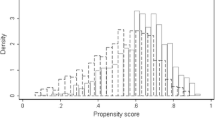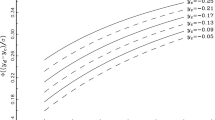Abstract
Our comment is a response to a recent paper in this Journal on non-completion rates in UK universities (Johnes and Taylor 1989). The causal inferences which that paper draws are ill-founded because they are based on data aggregated to university level. Individual-level data are essential, and data on other levels may also be necessary. We make other criticisms, and also comment on implications for performance indicators.
Similar content being viewed by others
References
Aitkin, M. and Longford, N. (1986). ‘Statistical modelling issues in school effectiveness studies’, Journal of the Royal Statistical Society, A, 149 (1), pp. 1–42.
Diamond, D. (1980). ‘A comparison of SCE and GCE school qualifications as predictors of university performance’, Ph.D. Thesis, University of St Andrews.
Dixon, M. (1989). ‘Benefits, and risks, of trying for a degree’, Financial Times, 19 April 1989.
Farrant, J. H. (1981). ‘Trends in admissions’ in O. Fulton (ed.). Access to Higher Education, Guildford: Society for Research in Higher Education.
Goldstein, H. (1987). Multilevel Models in Educational and Social Research, London: Griffin.
Johnes, J. and Taylor, J. (1987). ‘Degree quality: An investigation into differences between UK universities’, Higher Education, 16, pp. 581–602.
Johnes, J. and Taylor, J. (1989). ‘Undergraduate non-completion rates: Differences between UK universities’, Higher Education, 18, pp. 209–225.
Jones, C. L. (1972). ‘Paths to honours: some recursive models of academic achievement’, Edinburgh: Edinburgh University Centre for Educational Sociology.
Jones, C. L., Mackintosh, H. and McPherson, A. F. (1972). ‘Questions of uncertainty: Non-cognitive predictors of first year achievement at university’, in C. Flood Page and J. Gibson (eds.) Motivation, London: Society for Research in Higher Education.
Jones, C. L., McMichael, P. and McPherson, A. F. (1973). ‘Residence and the first year’, Universities' Quarterly, 28 (1), pp. 101–122.
MacLeod, D. (1989). ‘Puzzle of high drop-out rate among students’, The Scotsman, 3 October 1989.
McPherson, A. F. (1973). ‘Selections and survivals: A sociology of the ancient Scottish universities’, in R. Brown (ed.) Knowledge, Education and Cultural Change, London: Tavistock.
McPherson, A. F. (1975). ‘National differences in pedagogy and first-year achievement at Edinburgh University’, Scottish Educational Studies, 7 (2), pp. 49–66.
McPherson, A. F. and Neave, G. R. (1976). The Scottish Sixth, Slough: National Foundation for Educational Research.
McPherson, A. F. (1983). ‘Comments’ in N. Phillipson (ed.) Universities, Society and the Future, Edinburgh: Edinburgh University Press.
Paterson, L. (1989). ‘Trends in attainment in Scottish schools’, Paper presented to the ESRC International Conference on Multilevel Methods in Educational Research, Edinbugh, 12–13 August.
Powell, J. L. (1973). Selection for University in Scotland, London: University of London, Press for the Scottish Council for Research in Education.
Raudenbush, S. and Bryk, A. (1986). ‘A hierarchical model for studying school effects’, Sociology of Education, 59, pp. 1–17.
Robinson, W. S. (1950). ‘Ecological correlations and the behaviour of individuals’, American Sociological Review, 15, pp. 351–357.
Scottish Council for Research in Education (1937). The Prognostic Value of University Entrance Examinations in Scotland, London: University of London Press.
Scottish Education Department (1985). Future Strategy for Higher Education in Scotland, Edinburgh: HMSO, CMND. 9676.
Scottish Education Department (1989). ‘University Students’, Statistical Bulletin, No. 3/H1/1989.
Scottish Education Department/ Scottish Examination Board (1982). Full-time Education after S4: A Statistical Study, Dalkeith: SEB.
Sear, K. (1983). ‘The correlation between A-level grades and degree results in England and Wales’, Higher Education, 12, pp. 609–616.
Universities' Statistical Record. University Statistics 1987–8, vol. 1: Students and Staff, Cheltenham: USR.
Willms, J. D. (1986). ‘Social-class segregation and its relationship to pupils’ examination results in Scotland’, American Sociological Review, 51, pp. 224–241.
Willms, J. D. and Raudenbush, S. W. (in press). ‘A longitudinal hierarchical linear model for estimating school effects and their stability’, Journal of Educational Measurement.
Woodhouse, G. and Goldstein, H. (1988). ‘Educational performance indicators and LEA league tables’, Oxford Review of Education, 14 (3), pp. 301–320.
Author information
Authors and Affiliations
Rights and permissions
About this article
Cite this article
McPherson, A., Paterson, L. Undergraduate non-completion rates: a comment. High Educ 19, 377–383 (1990). https://doi.org/10.1007/BF00133899
Issue Date:
DOI: https://doi.org/10.1007/BF00133899




